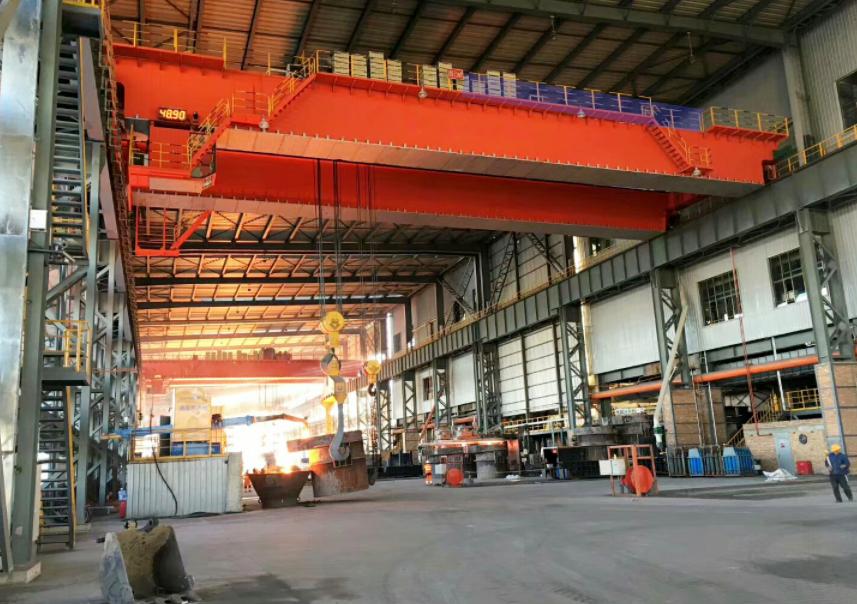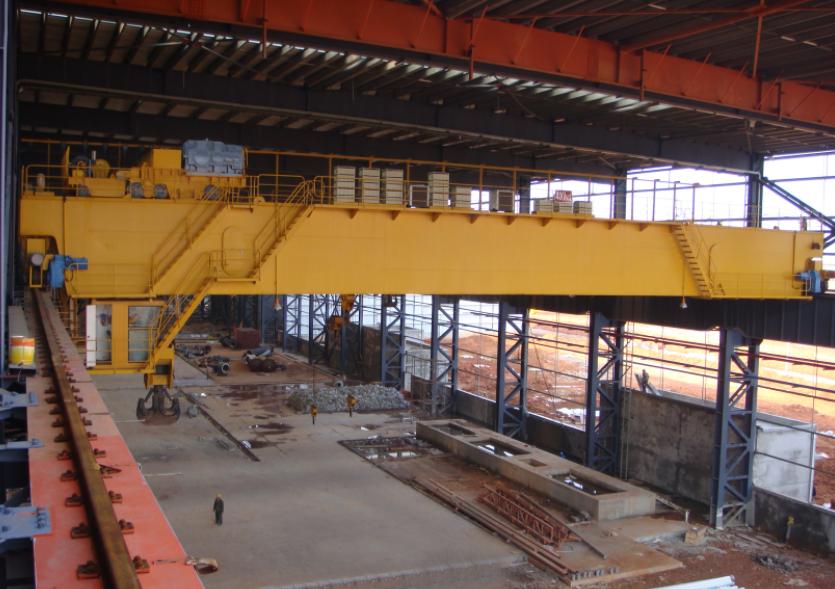Workshop Overhead Crane Operation in High-Temperature or Cold Environments
Overhead cranes are indispensable in modern workshops and industrial facilities, handling heavy materials efficiently and safely. However, operating these cranes in extreme temperature conditions—whether high heat or severe cold—poses unique challenges. The performance of crane components, the safety of operators, and the reliability of the lifting process can all be significantly affected by temperature extremes. Understanding these factors and implementing proper operational strategies is crucial for maintaining safety, efficiency, and the longevity of crane equipment.

1. Impact of High-Temperature Environments on Overhead Cranes
High-temperature environments, such as foundries, steel plants, or facilities handling hot materials, can expose workshop overhead cranes to prolonged heat stress. Temperatures exceeding 40°C (104°F) can affect both the mechanical and electrical components of cranes. Some of the key challenges include:
1.1 Electrical Component Stress
Overhead cranes rely heavily on electrical systems for hoists, trolleys, and bridge movements. Excessive heat can cause insulation deterioration, overheating of motors, and failure of control systems. Variable frequency drives (VFDs), relays, and circuit boards are particularly sensitive to temperature fluctuations. Heat can accelerate the aging of insulating materials in cables and lead to increased resistance, ultimately affecting power transmission efficiency.
1.2 Mechanical Wear and Deformation
High temperatures can also impact the mechanical components of cranes. Steel beams, wire ropes, and trolley mechanisms can expand, resulting in dimensional changes that affect alignment and movement precision. For instance, long-span crane girders may experience slight bending or sagging, which, if unaccounted for, could cause uneven load distribution or even mechanical binding in trolley wheels and bridge rails.
1.3 Lubrication Challenges
Lubricants in crane gearboxes, hoist motors, and wheel bearings are formulated to perform within specific temperature ranges. Extreme heat can reduce lubricant viscosity, increasing friction and wear on critical components. This can lead to premature failure of gears, bearings, and wire ropes. High-temperature-resistant lubricants may be required for cranes operating continuously in hot workshops.
1.4 Operator Safety and Comfort
High temperatures pose a direct risk to crane operators, particularly in facilities where operators are stationed in cabins without proper cooling systems. Heat stress, dehydration, and reduced concentration can compromise safe crane operation. Ensuring air-conditioned cabins, regular breaks, and hydration protocols is essential.

2. Challenges of Low-Temperature Operation
Cold environments, such as those in refrigerated warehouses, cryogenic processing plants, or outdoor industrial facilities in winter, present a different set of challenges. Temperatures below 0°C (32°F) can affect crane performance in several ways:
2.1 Metal Brittleness
Steel and other metals become more brittle at low temperatures. Structural components, hoist hooks, wire ropes, and chains can fracture more easily under stress. Designers must select materials that maintain toughness at low temperatures and adhere to safety factors specific to cold environments.
2.2 Hydraulic and Lubrication Issues
Cold temperatures increase the viscosity of oils and lubricants, reducing their effectiveness. Hydraulic systems in cranes may operate sluggishly, affecting precise load positioning. Bearings, gears, and wire ropes may experience increased friction, leading to wear and operational delays. Using low-temperature-rated lubricants and conducting regular maintenance checks is essential in cold workshops.
2.3 Electrical Performance
Batteries, motors, and control systems can be affected by cold. Low temperatures can reduce battery capacity, slow motor response, and even cause condensation-related short circuits if equipment is moved between temperature zones. Proper insulation, heating elements for electrical cabinets, and anti-condensation measures are critical.
2.4 Operator Safety
Operating cranes in cold environments affects human performance as well. Reduced dexterity due to thick gloves, slower reaction times, and risks of frostbite or hypothermia can compromise safe operation. Heated cabins, insulated clothing, and safety protocols for cold stress are necessary for maintaining operator safety and efficiency.
3. Engineering Considerations for Extreme Temperature Operation
Designing and operating overhead cranes in extreme temperature environments requires a careful selection of materials, components, and protective measures:
3.1 Material Selection
- High-temperature environments: Use heat-resistant steels and alloys that maintain strength and toughness. Select wire ropes rated for elevated temperatures and avoid materials prone to rapid thermal expansion.
- Low-temperature environments: Use steels with good low-temperature toughness, such as A36 or ASTM A992 grades for structural components. Wire ropes and chains should be rated for low-temperature operations.
3.2 Lubrication Solutions
- Employ lubricants with high thermal stability in hot workshops. Synthetic oils with high viscosity indices help maintain lubrication under heat stress.
- Use low-temperature greases and oils in cold environments to ensure smooth movement of gears, bearings, and wire ropes. Regular lubrication inspections are essential to prevent failures.
3.3 Electrical System Protection
- In hot environments, ensure motors and control panels are ventilated or air-conditioned. Install temperature sensors and thermal cutoffs to prevent overheating.
- In cold environments, enclose electrical cabinets with heaters or use frost-proof designs. Ensure insulation of cables and wires to prevent brittleness and breakage.
3.4 Safety Devices and Monitoring
- Overhead cranes in extreme environments should be equipped with overload protection, anti-sway devices, and monitoring systems to detect mechanical stress or misalignment.
- Temperature sensors on motors, gearboxes, and critical components can provide early warnings of overheating or cold-induced failures.
4. Operational Strategies for Safe Crane Use
Even with robust engineering solutions, operational strategies play a critical role in maintaining crane performance and safety in extreme temperatures.
4.1 Pre-Operation Inspection
Operators should conduct thorough inspections before each shift, checking for:
- Structural integrity of beams and girders
- Condition of wire ropes, hooks, and chains
- Proper lubrication of mechanical components
- Electrical system functionality and temperature ratings
4.2 Adjusted Operating Speeds
High heat can reduce mechanical tolerances, while cold can increase friction. Operators may need to reduce crane speed during lifting, traversing, or hoisting to maintain safe operation and prevent mechanical stress.
4.3 Environmental Control
- High-temperature workshops: Implement cooling systems, shade structures, or ventilation to reduce ambient heat.
- Cold environments: Use cabin heaters, insulated walkways, and gradual temperature acclimation to prevent condensation and operator discomfort.
4.4 Maintenance Frequency
Extreme temperatures accelerate wear and reduce equipment lifespan. Maintenance intervals should be shortened, with particular attention to:
- Wire rope inspection for fraying or brittleness
- Gearbox and bearing lubrication
- Motor and electrical system performance
5. Case Studies and Practical Applications
5.1 Hot Workshop Example
In steel foundries, overhead cranes must lift molten metal ladles weighing tens of tons. The foundry cranes operate near furnaces with temperatures exceeding 50°C (122°F). High-temperature-resistant wire ropes, heat-insulated operator cabins, and constant monitoring of crane motors ensure safe operation. Failure to account for heat-induced expansion in crane girders can lead to misalignment and hoist jamming.
5.2 Cold Storage Facility Example
In refrigerated warehouses for frozen foods, cranes must handle palletized cargo at -25°C (-13°F). Wire ropes and chains designed for low temperatures, heated control cabins, and anti-freeze lubricants allow operators to safely and efficiently move materials. Insufficient precautions can result in brittle components snapping under load or electrical system failures due to condensation.
6. Conclusion
Operating workshop overhead cranes in extreme temperatures requires a combination of engineering foresight, proper maintenance, and operator training. High temperatures can cause overheating, mechanical expansion, and lubrication breakdown, while cold temperatures introduce brittleness, lubrication challenges, and reduced electrical performance. Safety devices, environmental controls, and careful operational procedures are essential for reliable performance.
By selecting appropriate materials, employing temperature-resistant components, and enforcing stringent inspection and maintenance routines, industrial facilities can ensure their overhead cranes operate safely and efficiently, regardless of environmental conditions. Ultimately, proactive planning and adaptation to extreme temperatures not only protect expensive equipment but also safeguard operators and enhance productivity in demanding industrial environments.